3D Simulation-Based Acoustic Wave Resonator Analysis and Validation Using Novel Finite Element Method Software
Abstract
1. Introduction
2. Film Bulk Acoustic Resonator Basics
2.1. Acoustic Wave Resonators
2.2. FBAR Design Considerations
2.3. Performance Metrics
3. 2D Simulations-Based Design Methodology for FBAR
4. 3D Simulations-Based Design Methodology for FBAR Using Onscale
4.1. Main Challenges for FEM Simulations of FBAR Devices
4.2. Device Design Methodology Supported by 3D Simulations
- 1.
- Main Specifications: First, the design specifications must be clearly defined. It is suitable to define criteria that can be modified to make decisions in the next steps of this methodology, as well as the tolerable range for each parameter in the design (i.e., resonance and anti-resonance frequencies, insertion loss, bandwidth, required area, etc.)
- 2.
- 2D model: Two-dimensional modeling allows to carry out a harmonic analysis in order to know the main resonance modes. In this stage, the materials of the device, their thickness and their boundary conditions are defined. The main criterion to go to the next step is the match between the resonance and anti-resonance frequencies of the model with the specifications defined in Step 1.
- 3.
- 3D model: The input for 3D modeling will be the configuration of materials and thicknesses established in Step 2: however, in the 3D simulation, the effects of the density of the materials, the shape of the electrodes, the active area, and the effect of anchors, among others, will be observed. It is very important to consider an optimized mesh resulting of the mesh study. Boundary conditions play a very important role in the simulation; for this reason, they must be well defined and located. The main criteria to go to Step 4 is the value of the mechanical coupling and the quality factor of the device. Their values will be defined by the analysis of the effects of geometry, material properties, and boundary conditions. The values of these parameters should be correlated with the tolerance ranges defined in Step 1.
- 4.
- Device Manufacturing The manufacture of the device will be carried out when a functional design is obtained in 3D simulations as expected. This is where a feedback between device manufacturing constraints and 3D modeling should be done to consider any possible effect of the manufacturing constraints. At this stage, it is convenient to define the feasibility of the prototype designed in 3D and simulate as many times as necessary the thicknesses achievable by the available deposition equipment resolution and all the modifications that the manufacturing tolerances impose on the design.
- 5.
- Device Validation: After the manufacturing process, the feedback given to the 3D simulation is very important, correcting the dielectric, acoustic or structural losses necessary so that the response in the simulation is as close as possible to the measurement of the device. In this way, the effects of the process are captured in the 3D modeling. This will allow the following cycles to consider these effects so that the designer can apply design techniques to reduce losses or suppress spurious resonances. The validation of the model will be carried out by comparing the specifications given in the first step with the result of the manufactured device. If the response of the device is far from what is expected, the cycle repeats.
5. Study Case
5.1. Geometry Definition: Materials, Physics and Constraints
5.2. Mesh Study
5.3. Losses Analysis
5.4. Comparison Results
6. Discussion
- Mesh size optimization: Computation time can be reduced when using OnScale compared with conventional software. It allows to run mesh optimization techniques for a mesh size . OnScale provides the confidence of well meshed structures without losing wave information.
- Better capture of Manufacturing aspects: Fabrication process is a hard task when acoustic resonators are being manufactured. Fabrication defects can be included as part of the simulation in order to approach the final device before manufacturing.
- Broadband capability: Time domain solvers allow simulations to represent a broad spectrum of frequencies in the order of GHz. This allows capturing not only the main resonance frequency but a range of spurious responses, as well.
- Analysis flexibility in combination with post-processing tools: powerful tools, like OnScale, enable interfacing with general purpose numeric environments, like MATLAB. This introduces a level of flexibility to enable post-processing steps, like the ones demonstrated in this paper, related with dielectric loss analysis.
- Easier tool adoption: FEM solvers running on the cloud provide an alternative to the initial capital investment and the related costs of maintaining an HPC infrastructure.
- Learning Curve: The powerful capabilities of modern FEM solvers, like OnScale, demand learning new information about the use of the software tool. Despite the advantages of a versatile Graphical User Interface (GUI), many commands and options must be learned. Additionally, some tasks may only be configured using a lower level scripting interface mode (called Analyst mode in OnScale) that also require a learning curve.
- Frequency resolution: Common to all FEM time domain solvers, the broadband capability mentioned in the advantages introduces a trade-off in frequency resolution. Fine frequency resolution imply a larger time analysis that may potentially override the bandwidth advantage.
- Cost: Despite the advantage of leveraging the capital investments and cost of procuring and maintaining HPC infrastructure, the cost of the cloud services are still of critical consideration. Cloud services are charged by the core-hour that is a measure of the level of computing resources required. Depending on the complexity of the model, the analysis may require in the hundreds or thousands of core-hours even if following the mentioned methods to reduce computation requirements. This also increases the cost of modeling or analysis setup errors. Modeling or analysis setups that end-up in invalid simulation results also bear the consequent monetary costs of wasted cloud service time.
7. Conclusions
Author Contributions
Funding
Institutional Review Board Statement
Informed Consent Statement
Data Availability Statement
Acknowledgments
Conflicts of Interest
References
- Ruby, R. A Snapshot in Time: The Future in Filters for Cell Phones. IEEE Microw. Mag. 2015, 16, 46–59. [Google Scholar] [CrossRef]
- Yantchev, V.; Katardjiev, I. Thin film Lamb wave resonators in frequency control and sensing applications: A review. J. Micromech. Microeng. 2013, 23. [Google Scholar] [CrossRef]
- Pang, W.; Ruby, R.C.; Parker, R.; Fisher, P.W.; Unkrich, M.A.; Larson, J.D. A Temperature-Stable Film Bulk Acoustic Wave Oscillator. IEEE Electron Device Lett. 2008, 29, 315–318. [Google Scholar] [CrossRef]
- Su, Y.; Chen, C.; Pan, H.; Yang, Y.; Chen, G.; Zhao, X.; Li, W.; Gong, Q.; Xie, G.; Zhou, Y.; et al. Muscle Fibers Inspired High-Performance Piezoelectric Textiles for Wearable Physiological Monitoring. Adv. Funct. Mater. 2021, 2010962. [Google Scholar] [CrossRef]
- Lin, Z.; Yang, J.; Li, X.; Wu, Y.; Wei, W.; Liu, J.; Chen, J.; Yang, J. Large-scale and washable smart textiles based on triboelectric nanogenerator arrays for self-powered sleeping monitoring. Adv. Funct. Mater. 2018, 28, 1704112. [Google Scholar] [CrossRef]
- Zhou, Z.; Weng, L.; Tat, T.; Libanori, A.; Lin, Z.; Ge, L.; Yang, J.; Chen, J. Smart Insole for Robust Wearable Biomechanical Energy Harvesting in Harsh Environments. ACS Nano 2020, 14, 14126–14133. [Google Scholar] [CrossRef]
- Humberto, C. Acoustic Wave and Electromechanical Resonators: Concept to Key Applications; Artech House: Norwood, MA, USA, 2010. [Google Scholar]
- Ruby, R. 11E-2 Review and Comparison of Bulk Acoustic Wave FBAR, SMR Technology. IEEE Ultrason. Symp. Proc. 2007, 1029–1040. [Google Scholar] [CrossRef]
- Lakin, K.M. Thin film resonators and filters. IEEE Ultrason. Symp. 1999, 2, 895–906. [Google Scholar] [CrossRef]
- Simon, G.; Patel, M.S.; Tweedie, A.; Harvey, G. Energy Spectrum Analysis for Optimal Design of Ultra-High Frequency (UHF) Piezoelectric Resonators Leveraging 3D FEA Domain Decomposition Method with Cloud HPC. In Proceedings of the IEEE International Ultrasonics Symposium (IUS), Las Vegas, NV, USA, 6–11 September 2020; pp. 1–4. [Google Scholar] [CrossRef]
- Patel, R. Fabrication and RF characterization of zinc oxide based Film Bulk Acoustic Resonator. Superlattices Microstruct. 2018, 118, 104–115. [Google Scholar] [CrossRef]
- You, K.; Choi, H. Inter-Stage Output Voltage Amplitude Improvement Circuit Integrated with Class-B Transmit Voltage Amplifier for Mobile Ultrasound Machines. Sensors 2020, 20, 6244. [Google Scholar] [CrossRef]
- Shung, K.K. Diagnostic Ultrasound: Imaging and Blood Flow Measurements; CRC Press: Boca Raton, FL, USA, 2006. [Google Scholar]
- Psychogiou, D.; Gómez-García, R.; Peroulis, D. Coupling-Matrix-Based Design of High-Q Bandpass Filters Using Acoustic-Wave Lumped-Element Resonator (AWLR) Modules. IEEE Trans. Microw. Theory Tech. 2015, 63, 4319–4328. [Google Scholar] [CrossRef]
- Hashimoto, K. RF Bulk Acoustic Wave Filters for Communications; Artech House: Norwood, MA, USA, 2009. [Google Scholar]
- Azhari, H.P. Basics of Biomedical Ultrasound for Engineers; John Wiley & Sons: Hoboken, NJ, USA, 2010. [Google Scholar]
- Kim, J.; Kim, K.; Choe, S.-H.; Choi, H. Development of an Accurate Resonant Frequency Controlled Wire Ultrasound Surgical Instrument. Sensors 2020, 20, 3059. [Google Scholar] [CrossRef]
- Uzunov, I.S.; Terzieva, M.D.; Nikolova, B.M.; Gaydazhiev, D.G. Extraction of modified butterworth—Van Dyke model of FBAR based on FEM analysis. In Proceedings of the XXVI International Scientific Conference Electronics (ET), Sozopol, Bulgaria, 13–15 September 2017; pp. 1–4. [Google Scholar] [CrossRef]
- Asseko Ondo, J.C.; Blampain, E.J.J.; N’Tchayi Mbourou, G.; Mc Murtry, S.; Hage-Ali, S.; Elmazria, O. FEM Modeling of the Temperature Influence on the Performance of SAW Sensors Operating at GigaHertz Frequency Range and at High Temperature Up to 500 ∘C. Sensors 2020, 20, 4166. [Google Scholar] [CrossRef] [PubMed]
- Nguyen, N.; Johannessen, A.; Rooth, S.; Hanke, U. A Design Approach for High-Q FBARs With a Dual-Step Frame. IEEE Trans. Ultrason. Ferroelectr. Freq. Control 2018, 65, 1717–1725. [Google Scholar] [CrossRef]
- Acevedo-Mijangos, J.; Ramírez-Treviño, A.; May-Arrioja, D.A.; LiKamWa, P.; Vázquez-Leal, H.; Herrera-May, A.L. Design and fabrication of a microelectromechanical system resonator based on two orthogonal silicon beams with integrated mirror for monitoring in-plane magnetic field. Adv. Mech. Eng. 2019, 11, 1–16. [Google Scholar] [CrossRef]
- Hernández-Sebastián, N.; Díaz-Alonso, D.; Renero-Carrillo, F.J.; Villa-Villaseñor, N.; Calleja-Arriaga, W. Design and Simulation of an Integrated Wireless Capacitive Sensors Array for Measuring Ventricular Pressure. Sensors 2018, 18, 2781. [Google Scholar] [CrossRef] [PubMed]
- Ibarra-Villegas, F.J.; Ortega-Cisneros, S.; Moreno-Villalobos, P.; Sandoval-Ibarra, F.; Del Valle-Padilla, J.L.; Raygoza-Panduro, J.J. Analysis of MEMS structures to identify their frequency response oriented to acoustic applications. Superficies y Vacío 2015, 28, 12–17. [Google Scholar]
- Giraud, S.; Bila, S.; Aubourg, M.; Cros, D. 3D simulation of thin-film bulk acoustic wave resonators (FBAR). In Proceedings of the 13th IEEE International Conference on Electronics, Circuits and Systems, Nice, France, 10–13 December 2006; pp. 1038–1041. [Google Scholar] [CrossRef]
- Thalamher, R.; Larson, J. Finite Element Analysis of BAW Devices: Principles and Perspectives. In Proceedings of the IEEE International Ultrasonics Symposium Proceedings, Taipei, Taiwan, 21–24 October 2015; Volume 15. [Google Scholar]
- Biswas, A.; Pawar, V.S.; Menon, P.K.; Pal, P.; Pandey, A.K. Influence of fabrication tolerances on performance characteristics of a MEMS gyroscope. Microsyst. Technol. 2020, 1–5. [Google Scholar] [CrossRef]
- Achour, B.; Attia, G.; Zerrouki, C.; Fourati, N.; Raoof, K.; Yaakoubi, N. Simulation/Experiment Confrontation, an Efficient Approach for Sensitive SAW Sensors Design. Sensors 2020, 20, 4994. [Google Scholar] [CrossRef]
- Lerch, R. Simulation of piezoelectric devices by two- and three-dimensional finite elements. IEEE Trans. Ultrason. Ferroelectr. Freq. Control 1990, 37, 233–247. [Google Scholar] [CrossRef]
- Reddy, J.N. Introduction to the Finite Element Method, 2nd ed.; Computer Implementation, Chapter; McGraw-Hill Education: New York, NY, USA, 1993. [Google Scholar]
- Kumar, Y.; Rangra, K.; Agarwal, R. Design and Simulation of FBAR for Quality Factor Enhancement. MAPAN 2017, 32, 113–119. [Google Scholar] [CrossRef]
- Li, M.; Tang, H.X.; Roukes, M.L. Ultra-sensitive NEMS-based cantilevers for sensing, scanned probe and very high-frequency applications. Nat. Nanotechnol. 2007, 2, 114–120. [Google Scholar] [CrossRef]
- Lee, J.B.; Kim, H.J.; Kim, S.G.; Hwang, C.S.; Hong, S.H.; Shin, Y.H.; Lee, N.H. Deposition of ZnO thin films by magnetron sputtering for a film bulk acoustic resonator. Thin Solid Film. 2003, 435, 179–185. [Google Scholar] [CrossRef]
- Sayago, I.; Aleixandre, M.; Martinez, A.; Fernandez, M.J.; Santos, J.P.; Gutierrez, J.; Gracia, I.; Horrillo, M.C. Structural studies of zinc oxide films grown by RF magnetron sputtering. Synth. Met. 2005, 148, 37–41. [Google Scholar] [CrossRef]
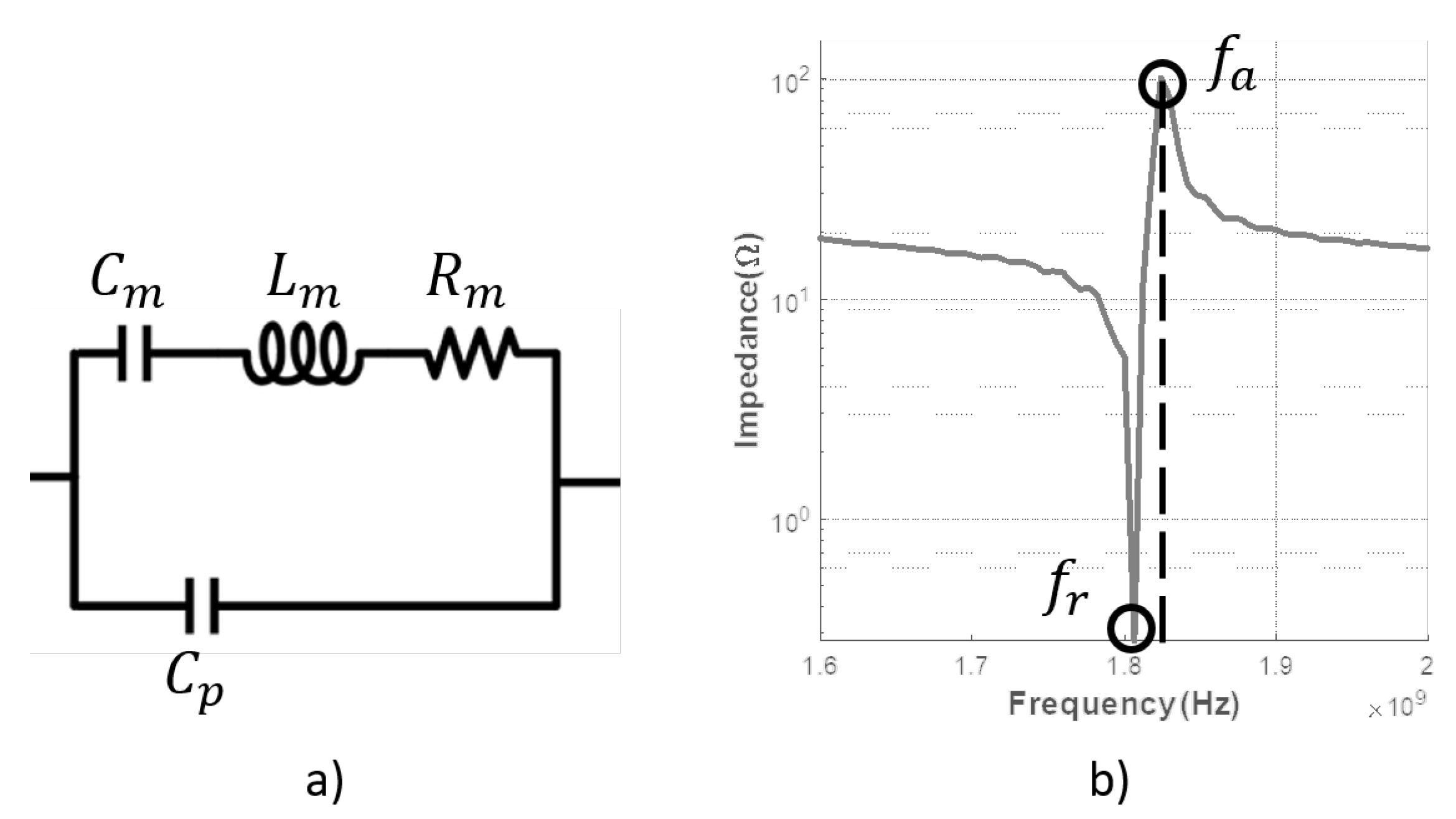

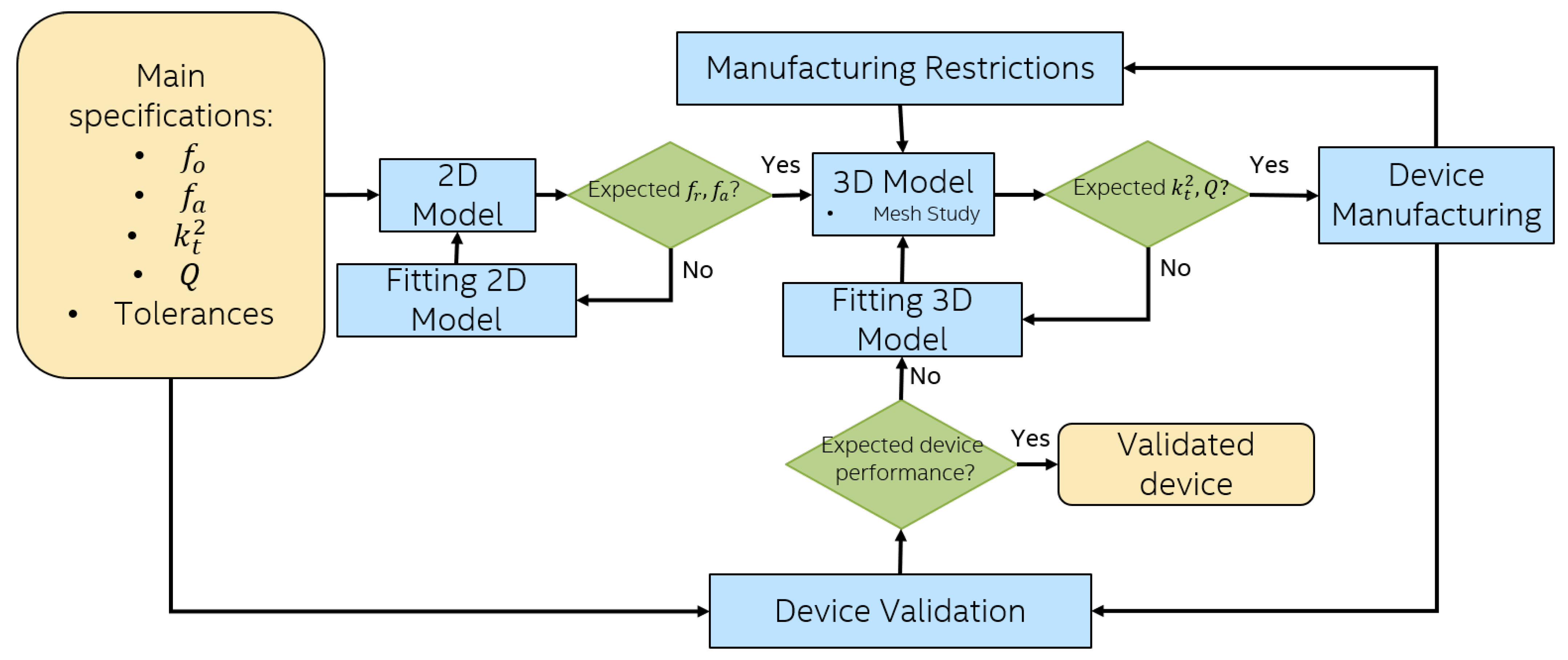

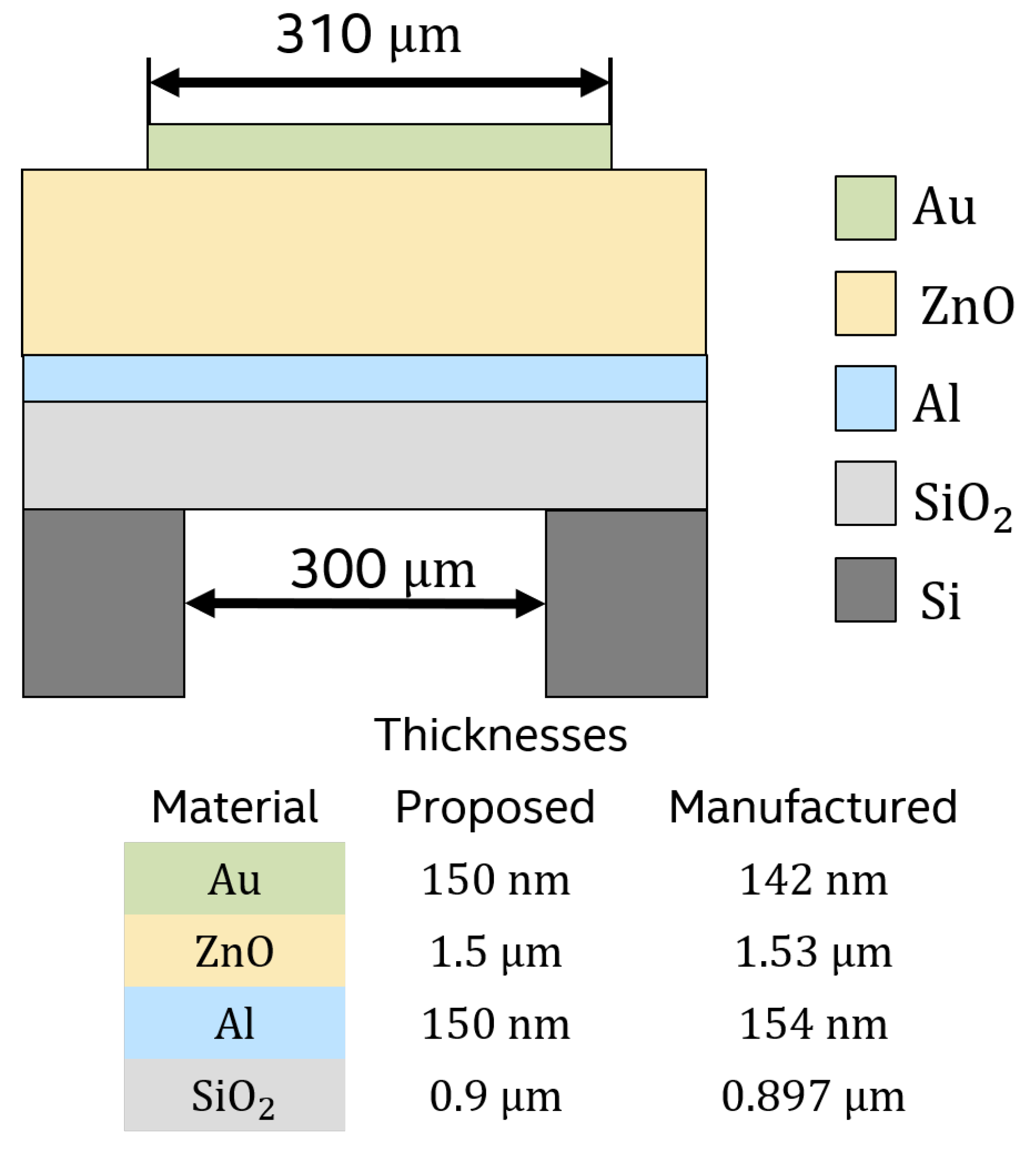

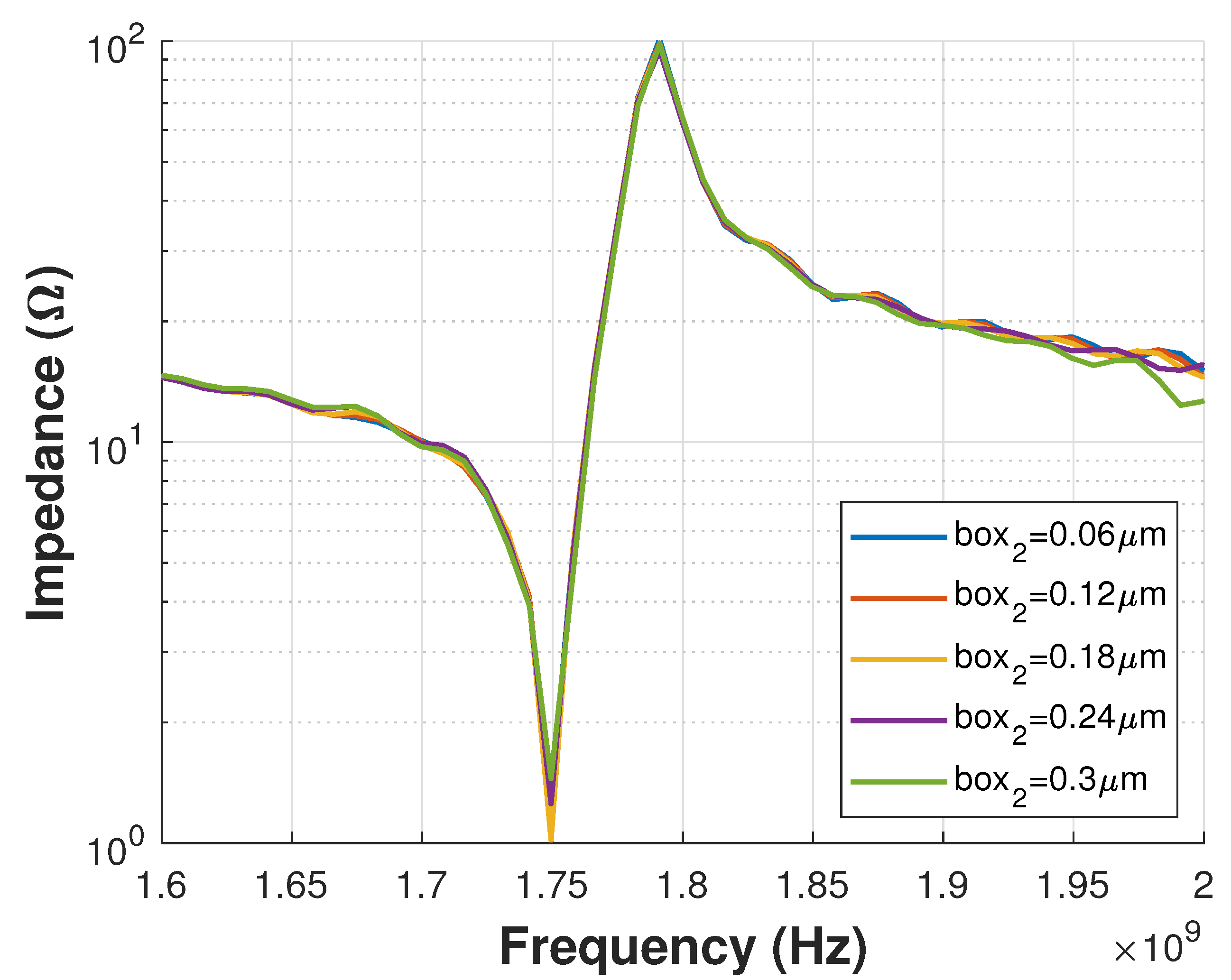

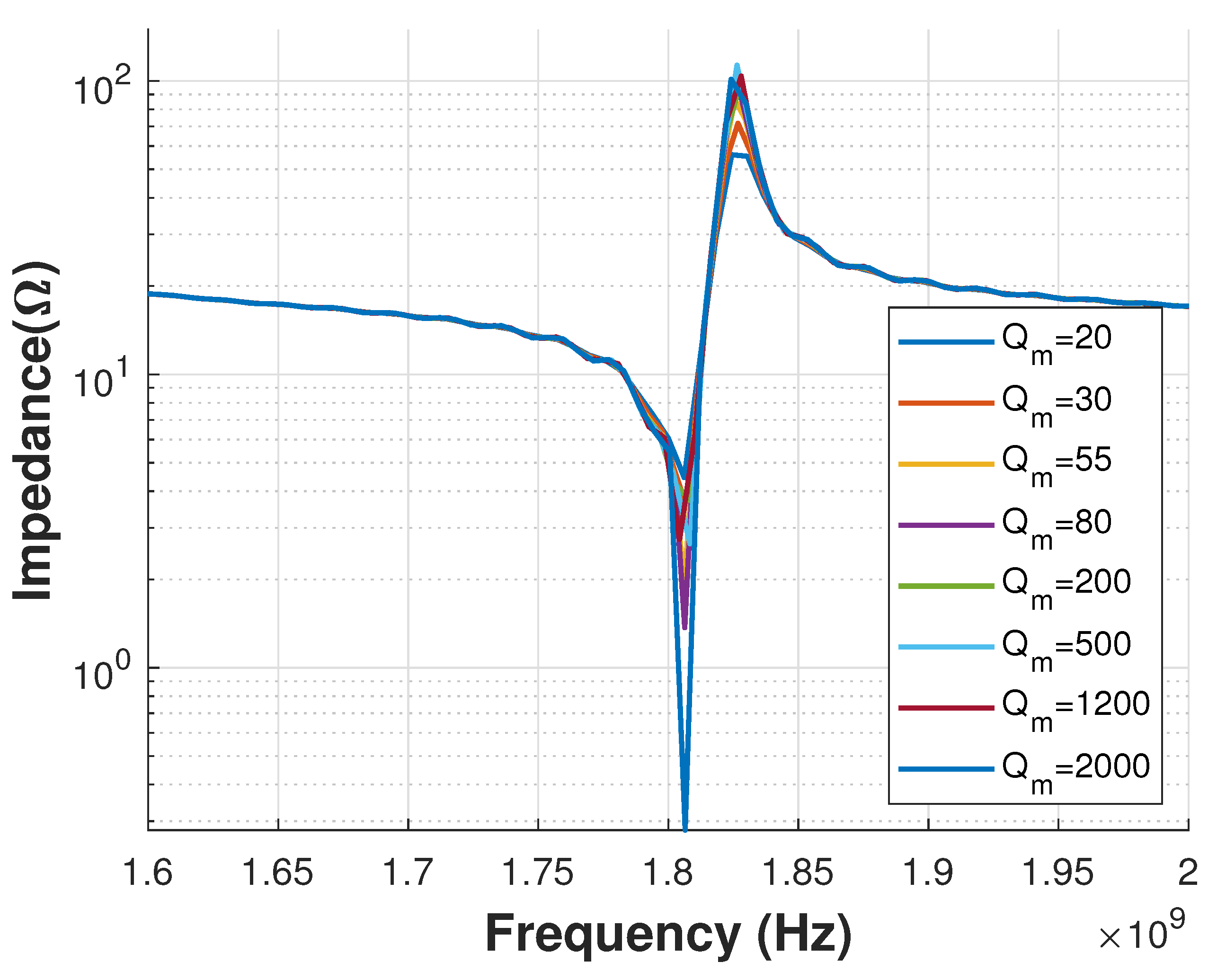
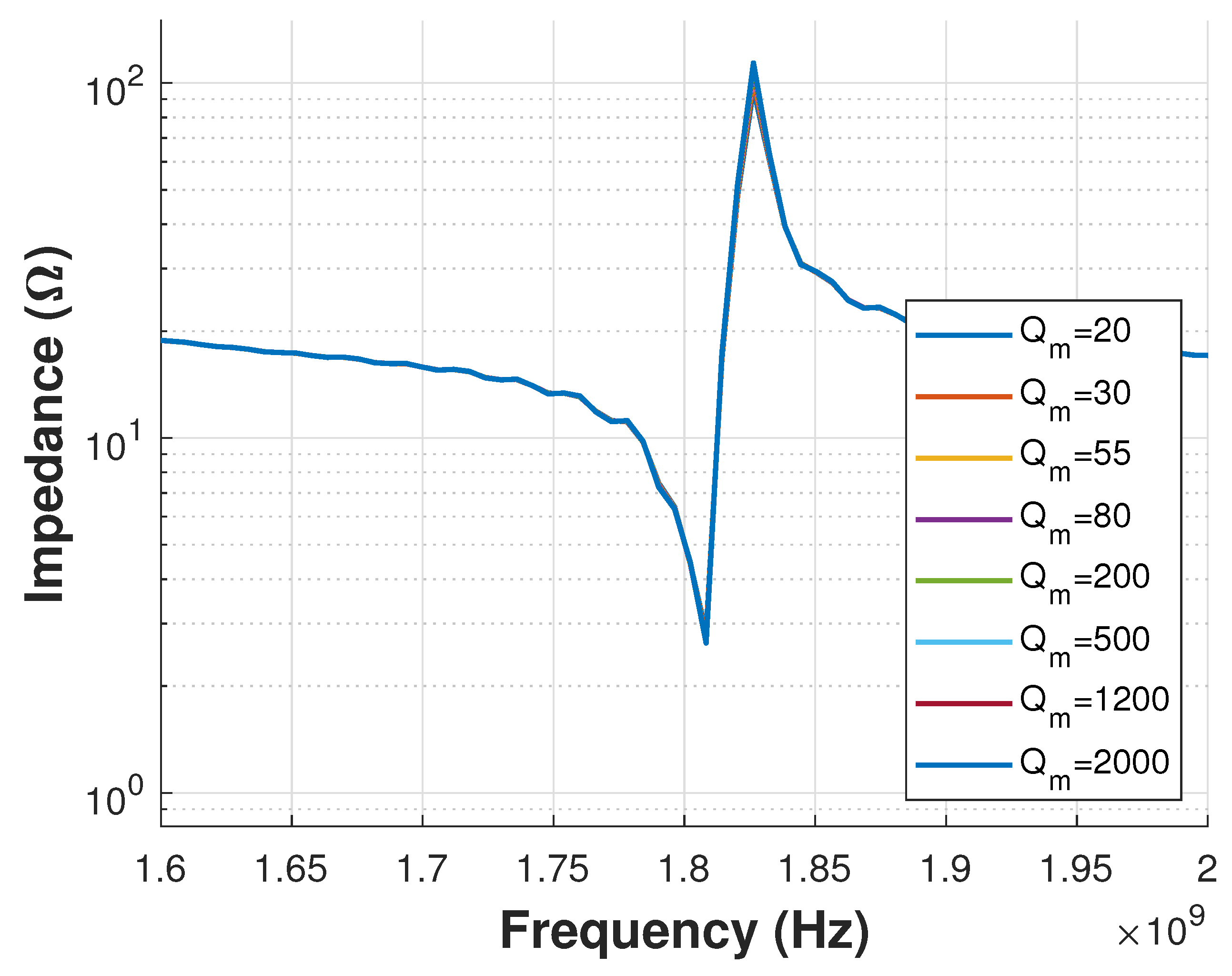
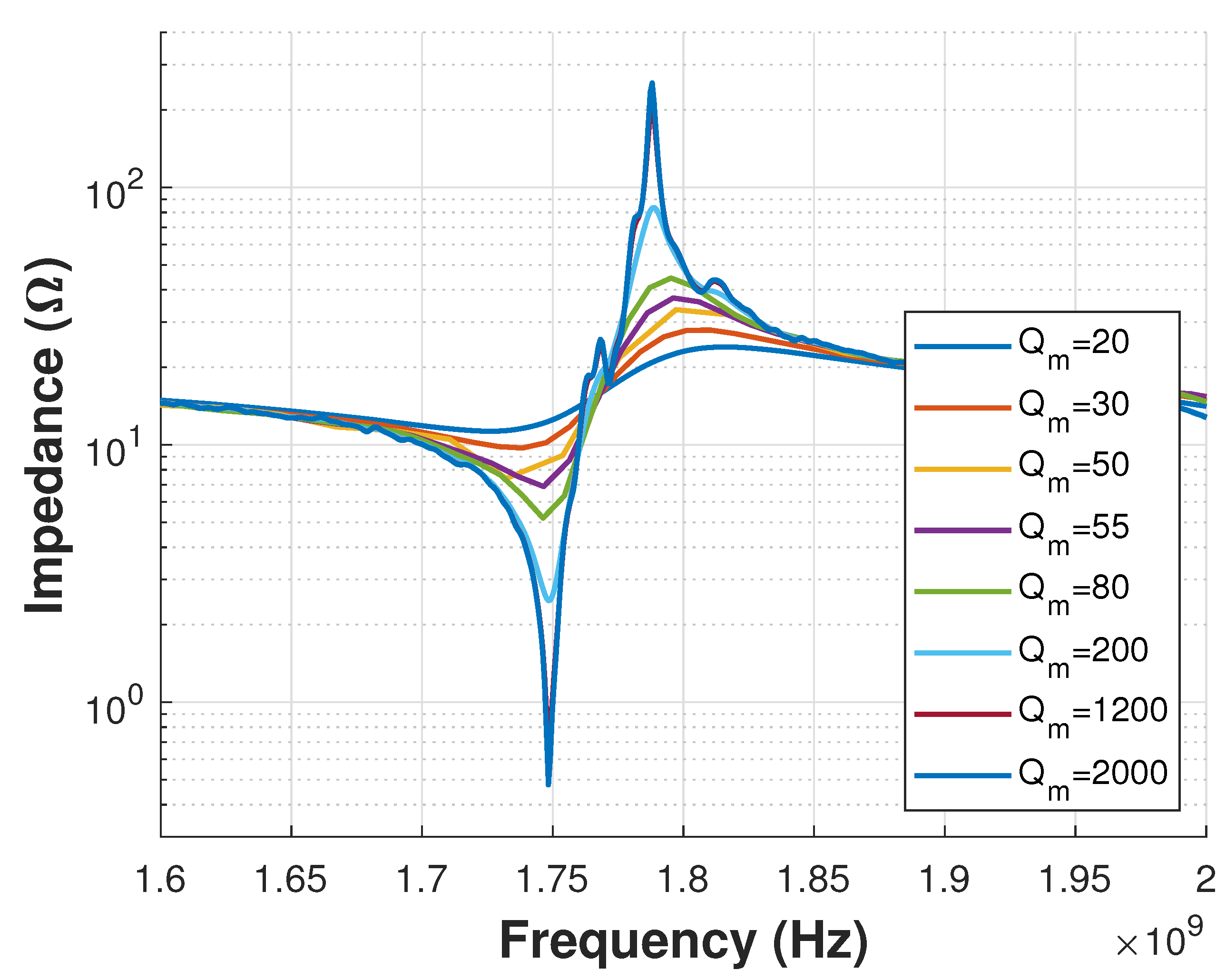

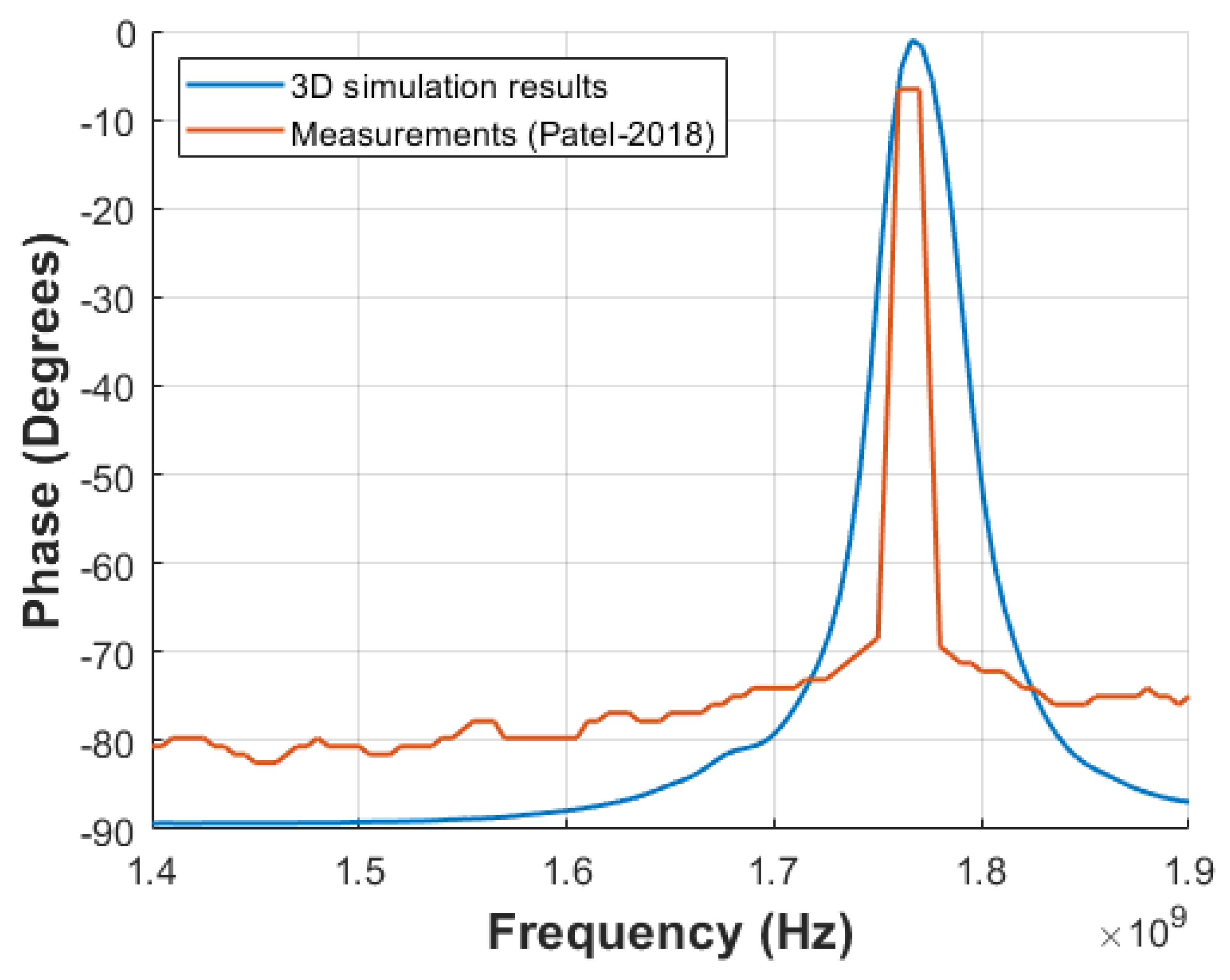
| = 50 | = 55 | = 80 | = 200 | = 1200 | = 2000 | |
|---|---|---|---|---|---|---|
| 1.7432 | 1.7464 | 1.7463 | 1.7483 | 1.7464 | 1.7464 | |
| 8.92 | 6.82 | 6.73 | 5.58 | 5.48 | 5.48 | |
| 28.61 | 39.83 | 53.67 | 143.5 | 541 | 767 | |
| 2.55 | 2.68 | 3.62 | 8.00 | 29.65 | 42.03 |
| Measurements | 3D Results | |
|---|---|---|
| [GHz] | 1.75 | 1.7464 |
| 4.154 | 6.82 | |
| 59.8 | 39.83 | |
| FoM | 2.48 | 2.68 |
Publisher’s Note: MDPI stays neutral with regard to jurisdictional claims in published maps and institutional affiliations. |
© 2021 by the authors. Licensee MDPI, Basel, Switzerland. This article is an open access article distributed under the terms and conditions of the Creative Commons Attribution (CC BY) license (https://creativecommons.org/licenses/by/4.0/).
Share and Cite
Vidana Morales, R.Y.; Ortega Cisneros, S.; Camacho Perez, J.R.; Sandoval Ibarra, F.; Casas Carrillo, R. 3D Simulation-Based Acoustic Wave Resonator Analysis and Validation Using Novel Finite Element Method Software. Sensors 2021, 21, 2715. https://doi.org/10.3390/s21082715
Vidana Morales RY, Ortega Cisneros S, Camacho Perez JR, Sandoval Ibarra F, Casas Carrillo R. 3D Simulation-Based Acoustic Wave Resonator Analysis and Validation Using Novel Finite Element Method Software. Sensors. 2021; 21(8):2715. https://doi.org/10.3390/s21082715
Chicago/Turabian StyleVidana Morales, Ruth Yadira, Susana Ortega Cisneros, Jose Rodrigo Camacho Perez, Federico Sandoval Ibarra, and Ricardo Casas Carrillo. 2021. "3D Simulation-Based Acoustic Wave Resonator Analysis and Validation Using Novel Finite Element Method Software" Sensors 21, no. 8: 2715. https://doi.org/10.3390/s21082715
APA StyleVidana Morales, R. Y., Ortega Cisneros, S., Camacho Perez, J. R., Sandoval Ibarra, F., & Casas Carrillo, R. (2021). 3D Simulation-Based Acoustic Wave Resonator Analysis and Validation Using Novel Finite Element Method Software. Sensors, 21(8), 2715. https://doi.org/10.3390/s21082715








